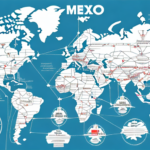How to Generate Accurate UPS Shipping Rates Quickly and Easily
Shipping is a fundamental component of any business that handles physical products. Ensuring that your shipping rates are accurate is crucial for fulfilling orders efficiently and maintaining cost-effectiveness. UPS is a leading shipping carrier renowned for its reliable service both across the United States and internationally. This article delves into strategies for generating accurate UPS shipping rates swiftly and effortlessly.
Why Accurate Shipping Rates are Important for Your Business
Accurate shipping rates are indispensable for businesses of all sizes, forming the bedrock of a robust shipping strategy that streamlines operations. Inaccurate rates can lead to unexpected costs, potentially eroding profits and compromising competitiveness. According to a 2023 Statista report, global e-commerce sales reached $6.54 trillion, underscoring the importance of precise shipping calculations in a booming market.
Moreover, precise shipping rates enable you to set trustworthy shipping costs for your customers, fostering trust and credibility. This reliability encourages repeat business and enhances customer loyalty, which is vital in highly competitive markets.
Accurate shipping rates also minimize customer complaints and negative reviews. Overcharging customers for shipping can lead to dissatisfaction and detrimental feedback on platforms like social media and review sites, damaging your business's reputation. Conversely, undercharging can result in financial losses, undermining long-term sustainability.
Additionally, leveraging accurate shipping data allows for informed business decisions. By analyzing shipping patterns, businesses can identify cost-saving opportunities and optimize their strategies. For example, recognizing that certain regions incur higher shipping costs can guide pricing and policy adjustments to maximize profitability and enhance customer satisfaction.
Understanding UPS Shipping Zones and How They Affect Your Rates
UPS determines shipping rates using a shipping zone system, which categorizes states and zip codes based on the distance between the origin and destination. The farther the distance, the higher the zone, resulting in increased shipping rates. Understanding UPS shipping zones is essential to accurately charge customers for shipping. Utilizing the UPS Shipping Calculator can help you determine the appropriate rates based on package weight and destination.
UPS updates its zone chart annually to reflect changes in logistics and pricing strategies. Staying informed about these updates is crucial to prevent discrepancies in shipping rates. Additionally, factors such as package type, selected service level, and shipping time can influence zone assignments. Always verify shipping rates before dispatching packages to avoid unexpected costs or delays.
How to Use UPS's Shipping Calculator Tool for Accurate Rates
UPS provides a comprehensive Shipping Calculator that factors in package weight, dimensions, origin, and destination to deliver precise shipping rates. To utilize the tool, visit the UPS website, input the necessary information, and the calculator will present applicable shipping options, including ground or air services.
The Shipping Calculator also offers advanced features such as rate comparisons across different shipping methods and the ability to schedule package pickups. Additionally, it provides estimated delivery dates and real-time package tracking, which are invaluable for businesses managing frequent shipments and aiming to enhance customer experience.
Tips for Packaging Your Products to Ensure Accurate Weight and Dimensions
Shipping rates hinge on accurate package weight and dimensions. Incorrect measurements can lead to inaccurate rate calculations, resulting in overcharges or undercharges. Select packaging materials that suit your product's size and weight, ensuring the package is both secure and durable. Adhering to UPS packaging guidelines is essential to maintain consistency in weight and dimension reporting, thus avoiding costly delays and additional fees.
The choice of packaging material is also crucial. Opt for materials that protect the product without unnecessarily increasing the package's weight. Additionally, eco-friendly packaging can appeal to environmentally conscious consumers, potentially serving as a unique selling point.
Proper labeling with accurate weight and dimensions is vital. Clear labeling prevents confusion and errors during transit. Ensure that both the exterior of the package and any accompanying shipping documents reflect the correct measurements.
How to Navigate UPS's Surcharge Fees and Avoid Hidden Costs
UPS imposes various surcharges and fees based on factors like package size, weight, origin, destination, and selected shipping method. Understanding these fees and integrating them into your rate calculations is essential for providing accurate shipping costs to customers and maintaining profitability. Comprehensive fee information can be found on the UPS website, or by consulting a UPS representative.
One prevalent surcharge is the Residential Delivery Surcharge, applied to packages delivered to residential addresses. This fee is independent of the package's weight or size and is based solely on the delivery location. To mitigate this surcharge, consider offering customers the option to pick up their packages at UPS locations or have them delivered to commercial addresses.
By anticipating and planning for these surcharges, businesses can ensure shipping costs remain predictable and manageable, enhancing financial planning and customer transparency.
Using UPS's API Integration for Seamless Rate Calculation in Your eCommerce Store
UPS offers robust API integration options that streamline the shipping process and ensure precise rate calculations within your eCommerce platform. Integrating the UPS API allows customers to view accurate shipping rates based on package specifics directly at checkout. This transparency empowers customers to make informed decisions, reducing cart abandonment and enhancing overall satisfaction.
Moreover, API integration automates various shipping processes, including packing slip generation and label printing, thereby saving time and reducing the potential for human error. This automation is particularly beneficial for businesses with high shipping volumes, enabling scalability and efficiency.
Ways to Negotiate Better Shipping Rates with UPS as a Business Owner
Business owners can negotiate more favorable shipping rates with UPS to bolster profitability. UPS offers a range of discount programs tailored to various shipping volumes and business locations. Engaging with a UPS representative to discuss your specific shipping needs can lead to customized solutions and potential rate reductions.
Additionally, comparing shipping rates with other carriers such as FedEx, USPS, and DHL ensures that you secure competitive rates. Regularly reviewing and renegotiating shipping agreements can help maintain optimal shipping costs as your business evolves.
Best Practices for Tracking Shipments and Ensuring Delivery Accuracy with UPS
Effective shipment tracking is crucial for providing accurate delivery estimates and maintaining customer trust. UPS offers multiple tracking options that allow you to monitor packages from dispatch to delivery. Utilizing the UPS Tracking Services enables real-time updates, ensuring that both you and your customers are informed about the shipment's status.
- Share tracking information proactively with customers to enhance transparency.
- Implement automated tracking notifications to keep customers informed without manual intervention.
- Consider offering shipping insurance to protect against unforeseen circumstances and ensure delivery accuracy.
Adhering to these best practices not only improves operational efficiency but also elevates the overall customer experience.
Comparing UPS's Shipping Rates to Other Carriers like FedEx, USPS, and DHL
Evaluating shipping rates across different carriers is essential for identifying the most cost-effective solutions tailored to your business needs. While UPS is a prominent player known for its reliability, other carriers like FedEx, USPS, and DHL offer competitive rates and services that may better align with specific shipping requirements.
Consider factors such as delivery speed, coverage area, package size limitations, and additional services when comparing carriers. Utilizing comparison tools and conducting periodic rate assessments can help ensure that your shipping strategy remains both competitive and financially sustainable.
How to Optimize Your Shipping Strategy for Cost Savings and Efficiency with UPS
Optimizing your shipping strategy involves balancing cost reduction, revenue enhancement, and improved customer satisfaction. UPS provides a variety of shipping services that cater to different business needs:
- UPS Ground: Ideal for non-urgent shipments, offering cost-effective rates with reliable delivery times.
- UPS Next Day Air: Suited for overnight shipments, ensuring rapid delivery for time-sensitive orders.
- UPS Worldwide Express: Best for international shipments, providing expedited delivery with comprehensive tracking.
Evaluating and selecting the appropriate UPS service based on shipment urgency, destination, and budget can significantly enhance your shipping efficiency and cost-effectiveness. Regularly reviewing and adjusting your shipping methods in response to business growth and market changes ensures that your strategy remains aligned with your operational goals.
Common Mistakes to Avoid When Generating UPS Shipping Rates
Generating UPS shipping rates accurately is critical to prevent cost discrepancies and delivery issues. Common pitfalls include:
- Incorrect Package Measurements: Ensure that both weight and dimensions are measured accurately to avoid incorrect rate calculations.
- Improper Packaging Materials: Using unsuitable packaging can distort package weight and dimensions, leading to inaccurate rates.
- Mislabeling Packages: Accurate labeling with correct weight, dimensions, and destination information is essential to prevent delivery errors.
To mitigate these issues, implement a standardized process for measuring and labeling packages. Regular training for staff involved in shipping can further reduce the likelihood of errors. Additionally, consulting with a UPS representative can provide guidance and address any concerns during the shipment creation process.
The Future of Shipping: Predictions for UPS's Rate Changes in the Coming Years
The shipping industry is evolving towards increased automation, transparency, and customer-centric services. The surge in e-commerce, accelerated by the COVID-19 pandemic, has driven significant growth, with online sales projected to continue expanding. According to a Statista report, global e-commerce sales are expected to reach $8.1 trillion by 2026.
In response to these trends, UPS is likely to continue adapting its rate structures and service offerings to meet the demands of a dynamic market. Innovations in technology, such as enhanced API integrations and automated logistics solutions, will play a pivotal role in shaping future rate structures and service efficiencies.
Businesses should stay informed about these developments to anticipate rate changes and adjust their shipping strategies accordingly. Embracing technological advancements and maintaining flexibility in shipping operations will be key to navigating the future landscape of shipping rates.
Case Studies: Success Stories of Businesses that Optimized their Shipping with UPS
Optimizing shipping strategies with UPS can lead to substantial benefits, including increased revenue, streamlined operations, and enhanced customer loyalty. Here are a few success stories:
- E-commerce Retailer Integration: An online store integrated the UPS API into their website, allowing customers to view accurate shipping rates at checkout. This transparency boosted customer trust, reduced cart abandonment rates by 15%, and increased overall revenue by 20% within a year.
- Manufacturing Cost Optimization: A manufacturing company revamped their packaging and adopted UPS Ground shipping for non-urgent deliveries. This change reduced their shipping costs by 10% annually while maintaining timely deliveries, thereby improving their profit margins.
- Subscription Box Service Scaling: A subscription box business partnered with UPS to utilize their tracking and insurance services. This partnership enhanced the reliability of deliveries, leading to a 25% increase in customer retention and a significant reduction in shipping-related customer service inquiries.
These examples illustrate how tailored shipping solutions and strategic partnerships with UPS can drive business growth and operational efficiency.
In conclusion, generating accurate UPS shipping rates is paramount for optimizing business operations and meeting customer expectations. Implementing the strategies and best practices outlined in this article will help you achieve precise shipping calculations, cost savings, and enhanced customer satisfaction. Staying abreast of industry developments and continuously refining your shipping strategy will ensure long-term success in the competitive landscape of e-commerce and physical product distribution.




















